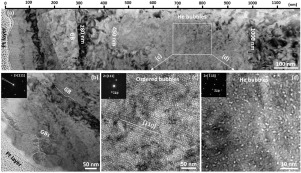当前位置:
X-MOL 学术
›
Acta Mater.
›
论文详情
Our official English website, www.x-mol.net, welcomes your
feedback! (Note: you will need to create a separate account there.)
Comparative Study of Radiation Defects in Ion Irradiated Bulk and Thin-Foil Tungsten
Acta Materialia ( IF 8.3 ) Pub Date : 2020-03-01 , DOI: 10.1016/j.actamat.2019.12.053 Ruo-Yao Zheng , Wei-Zhong Han
Acta Materialia ( IF 8.3 ) Pub Date : 2020-03-01 , DOI: 10.1016/j.actamat.2019.12.053 Ruo-Yao Zheng , Wei-Zhong Han

|
Abstract In this study, we employ transmission electron microscope (TEM) to analyze radiation defects in helium (He) and krypton (Kr) ions implanted bulk and thin-foil tungsten. For bulk tungsten, subgrains are formed near the surface region under both He+ and Kr+ irradiation. Dislocation loops are observed beyond ion implanted range. These observations are related to self-interstitial atoms (SIAs) diffusion and clustering. Ordered bubbles are formed in He+ implantation, while no cavities are detected in Kr+ irradiation. In thin-foil tungsten, line up of dislocation loops is found mainly aligns along {101} and {112} slip planes. Both 1/2 and 〈100〉 dislocation loops are identified. Compared to He+ irradiation, more 〈100〉 loops are detected in Kr+ irradiation due to higher energy collision cascade. Nanocavities are detected in irradiated thin-foil tungsten besides the formation of high density of interstitial loops. The number density of dislocation loops and the volume fractions of cavities are higher in He+ irradiation than in Kr+ irradiation. The differences in nature of radiation defects is attributed to the higher recombination rate of vacancies and interstitials in bulk sample, the significant surface sink effect in thin-foil irradiation and the chemical and physical effect of implanted ions.
中文翻译:

离子辐照大块和薄箔钨的辐射缺陷比较研究
摘要 在本研究中,我们使用透射电子显微镜 (TEM) 分析了注入体钨和薄箔钨的氦 (He) 和氪 (Kr) 离子的辐射缺陷。对于块状钨,在 He+ 和 Kr+ 照射下,在表面区域附近形成亚晶粒。在离子注入范围之外观察到位错环。这些观察结果与自填隙原子 (SIA) 扩散和聚集有关。在 He+ 注入中形成有序气泡,而在 Kr+ 辐射中未检测到空腔。在薄箔钨中,发现位错环的排列主要沿着 {101} 和 {112} 滑移面排列。1/2 和〈100〉位错环都被识别。与 He+ 辐射相比,由于更高能量的碰撞级联,在 Kr+ 辐射中检测到更多的<100> 环。除了形成高密度的间隙环外,在辐照的薄箔钨中还检测到纳米腔。He+辐照比Kr+辐照时位错环的数量密度和空腔的体积分数更高。辐射缺陷性质的差异归因于大块样品中空位和间隙的更高复合率,薄箔辐射中显着的表面下沉效应以及注入离子的化学和物理效应。
更新日期:2020-03-01
中文翻译:

离子辐照大块和薄箔钨的辐射缺陷比较研究
摘要 在本研究中,我们使用透射电子显微镜 (TEM) 分析了注入体钨和薄箔钨的氦 (He) 和氪 (Kr) 离子的辐射缺陷。对于块状钨,在 He+ 和 Kr+ 照射下,在表面区域附近形成亚晶粒。在离子注入范围之外观察到位错环。这些观察结果与自填隙原子 (SIA) 扩散和聚集有关。在 He+ 注入中形成有序气泡,而在 Kr+ 辐射中未检测到空腔。在薄箔钨中,发现位错环的排列主要沿着 {101} 和 {112} 滑移面排列。1/2 和〈100〉位错环都被识别。与 He+ 辐射相比,由于更高能量的碰撞级联,在 Kr+ 辐射中检测到更多的<100> 环。除了形成高密度的间隙环外,在辐照的薄箔钨中还检测到纳米腔。He+辐照比Kr+辐照时位错环的数量密度和空腔的体积分数更高。辐射缺陷性质的差异归因于大块样品中空位和间隙的更高复合率,薄箔辐射中显着的表面下沉效应以及注入离子的化学和物理效应。











































 京公网安备 11010802027423号
京公网安备 11010802027423号